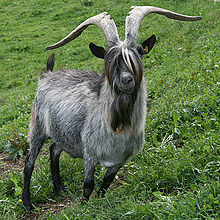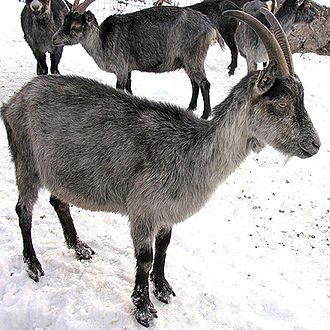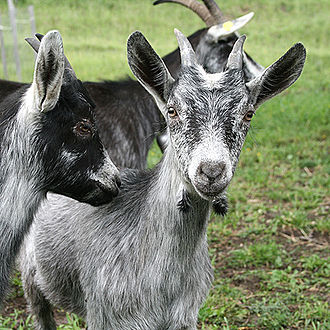Capra Grigia
 Billy-goat | |
| Conservation status | FAO (2007): critical-maintained[1]: 112 |
|---|---|
| Other names | |
| Country of origin | Switzerland |
| Distribution | |
| Standard | Capra Grigia Schweiz |
| Use |
|
| Traits | |
| Weight | |
| Height | |
| Wool colour | grey, lower legs black |
| Face colour | grey with paler muzzle |
| Horn status | horned in both sexes |
| |
The Capra Grigia, French: Chèvre grise des montagnes, German: Graue Bergziege,[3] is a rare and endangered indigenous breed of domestic goat from Switzerland. It originates in the valleys of the cantons of the Grisons or Graubünden in the eastern part of the country, and of Ticino or Tessin in the south.[4] It is possibly related to the grey type of the Passeirer Gebirgsziege from the Autonomous Province of Bolzano in north-eastern Italy.[5]
History[]
Documentation of the Capra Grigia in the valleys of the Ticino and the Grisons goes back more than 100 years. Three regional types were distinguished: the Bleni-Valmaggia or Lavizzarer, the Liviner or Misoxer, and the Riveria.[5] The breed was not recognised in the reorganisation of Swiss goat breeds in 1938, and infection with caprine arthritis encephalitis in the mid-twentieth century contributed to its near-total disappearance.[6] The Swiss association ProSpecieRara launched a conservation and recovery project for the Capra Grigia in 1997, recorded all surviving members in a herd-book, and started a controlled breeding programme. Breed standards were formulated in 2005, and in 2006 the Capra Grigia was officially recognised as a Swiss breed.[7]: 112 [8]: 367 In 2007 the total number registered was 190, and the conservation status was listed by the FAO as "critical-maintained".[1][8]: 367 In 2008, five apparently similar goats were discovered in the Valchiavenna in Italy, which increased the gene pool.[7] In 2011 a breed association, Capra Grigia Schweiz, was formed.[2]
At the end of 2011 a population of 475–490 was reported to DAD-IS.[3]
Characteristics[]
The Capra Grigia is sure-footed and agile, with hard hooves well-suited to the high mountain terrain of the southern Alps. The horns are strong, and grow upwards and outwards. The coat colour is similar to that of the Austrian : it varies from a mottled dark grey to a pale silver-white; the legs are dark grey or black, and there is a dark dorsal stripe.[8]: 367

Nanny goat

Kids
References[]
| Wikimedia Commons has media related to Capra Grigia. |
- ^ Jump up to: a b Barbara Rischkowsky, D. Pilling (eds.) (2007). List of breeds documented in the Global Databank for Animal Genetic Resources, annex to The State of the World's Animal Genetic Resources for Food and Agriculture. Rome: Food and Agriculture Organization of the United Nations. ISBN 9789251057629. Accessed June 2014.
- ^ Jump up to: a b Capra Grigia (in German). Pro Specie Rara. Accessed June 2014.
- ^ Jump up to: a b c d e f Breed data sheet: Capra Grigia/Switzerland. Domestic Animal Diversity Information System of the Food and Agriculture Organization of the United Nations. Accessed June 2014.
- ^ Tableaux des races: Races caprines suisses – races menacées (in French). Schweizerischer Ziegenzuchtverband. Archived 15 July 2014.
- ^ Jump up to: a b Hans-Peter Grunenfelder (ed.) (2003). Agricultural Genetic Resources in the Alps. St. Gallen: Monitoring Institute for Rare Breeds and Seeds in Europe. Accessed July 2017.
- ^ Programma di salvaguardia della razza Capra Grigia: Obiettivi e strategie dell’allevamento (in Italian). Capra Grigia Schweiz. Accessed June 2014.
- ^ Jump up to: a b Erhaltungsprojekt für Capra Grigia (in German). Pro Specie Rara. Accessed June 2014.
- ^ Jump up to: a b c Valerie Porter, Lawrence Alderson, Stephen J.G. Hall, D. Phillip Sponenberg (2016). Mason's World Encyclopedia of Livestock Breeds and Breeding (sixth edition). Wallingford: CABI. ISBN 9781780647944.
- Goat breeds
- Dairy goat breeds
- Goat breeds originating in Switzerland
- Goat stubs
- Switzerland stubs

